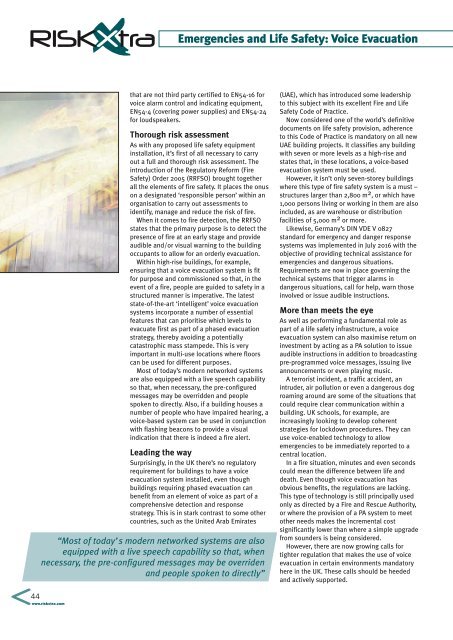RiskXtraSeptember2018
Create successful ePaper yourself
Turn your PDF publications into a flip-book with our unique Google optimized e-Paper software.
x<br />
RISKXtra<br />
Emergencies and Life Safety: Voice Evacuation<br />
that are not third party certified to EN54-16 for<br />
voice alarm control and indicating equipment,<br />
EN54-4 (covering power supplies) and EN54-24<br />
for loudspeakers.<br />
Thorough risk assessment<br />
As with any proposed life safety equipment<br />
installation, it’s first of all necessary to carry<br />
out a full and thorough risk assessment. The<br />
introduction of the Regulatory Reform (Fire<br />
Safety) Order 2005 (RRFSO) brought together<br />
all the elements of fire safety. It places the onus<br />
on a designated ‘responsible person’ within an<br />
organisation to carry out assessments to<br />
identify, manage and reduce the risk of fire.<br />
When it comes to fire detection, the RRFSO<br />
states that the primary purpose is to detect the<br />
presence of fire at an early stage and provide<br />
audible and/or visual warning to the building<br />
occupants to allow for an orderly evacuation.<br />
Within high-rise buildings, for example,<br />
ensuring that a voice evacuation system is fit<br />
for purpose and commissioned so that, in the<br />
event of a fire, people are guided to safety in a<br />
structured manner is imperative. The latest<br />
state-of-the-art ‘intelligent’ voice evacuation<br />
systems incorporate a number of essential<br />
features that can prioritise which levels to<br />
evacuate first as part of a phased evacuation<br />
strategy, thereby avoiding a potentially<br />
catastrophic mass stampede. This is very<br />
important in multi-use locations where floors<br />
can be used for different purposes.<br />
Most of today’s modern networked systems<br />
are also equipped with a live speech capability<br />
so that, when necessary, the pre-configured<br />
messages may be overridden and people<br />
spoken to directly. Also, if a building houses a<br />
number of people who have impaired hearing, a<br />
voice-based system can be used in conjunction<br />
with flashing beacons to provide a visual<br />
indication that there is indeed a fire alert.<br />
Leading the way<br />
Surprisingly, in the UK there’s no regulatory<br />
requirement for buildings to have a voice<br />
evacuation system installed, even though<br />
buildings requiring phased evacuation can<br />
benefit from an element of voice as part of a<br />
comprehensive detection and response<br />
strategy. This is in stark contrast to some other<br />
countries, such as the United Arab Emirates<br />
“Most of today’s modern networked systems are also<br />
equipped with a live speech capability so that, when<br />
necessary, the pre-configured messages may be overriden<br />
and people spoken to directly”<br />
(UAE), which has introduced some leadership<br />
to this subject with its excellent Fire and Life<br />
Safety Code of Practice.<br />
Now considered one of the world’s definitive<br />
documents on life safety provision, adherence<br />
to this Code of Practice is mandatory on all new<br />
UAE building projects. It classifies any building<br />
with seven or more levels as a high-rise and<br />
states that, in these locations, a voice-based<br />
evacuation system must be used.<br />
However, it isn’t only seven-storey buildings<br />
where this type of fire safety system is a must –<br />
structures larger than 2,800 m 2 , or which have<br />
1,000 persons living or working in them are also<br />
included, as are warehouse or distribution<br />
facilities of 5,000 m 2 or more.<br />
Likewise, Germany’s DIN VDE V 0827<br />
standard for emergency and danger response<br />
systems was implemented in July 2016 with the<br />
objective of providing technical assistance for<br />
emergencies and dangerous situations.<br />
Requirements are now in place governing the<br />
technical systems that trigger alarms in<br />
dangerous situations, call for help, warn those<br />
involved or issue audible instructions.<br />
More than meets the eye<br />
As well as performing a fundamental role as<br />
part of a life safety infrastructure, a voice<br />
evacuation system can also maximise return on<br />
investment by acting as a PA solution to issue<br />
audible instructions in addition to broadcasting<br />
pre-programmed voice messages, issuing live<br />
announcements or even playing music.<br />
A terrorist incident, a traffic accident, an<br />
intruder, air pollution or even a dangerous dog<br />
roaming around are some of the situations that<br />
could require clear communication within a<br />
building. UK schools, for example, are<br />
increasingly looking to develop coherent<br />
strategies for lockdown procedures. They can<br />
use voice-enabled technology to allow<br />
emergencies to be immediately reported to a<br />
central location.<br />
In a fire situation, minutes and even seconds<br />
could mean the difference between life and<br />
death. Even though voice evacuation has<br />
obvious benefits, the regulations are lacking.<br />
This type of technology is still principally used<br />
only as directed by a Fire and Rescue Authority,<br />
or where the provision of a PA system to meet<br />
other needs makes the incremental cost<br />
significantly lower than where a simple upgrade<br />
from sounders is being considered.<br />
However, there are now growing calls for<br />
tighter regulation that makes the use of voice<br />
evacuation in certain environments mandatory<br />
here in the UK. These calls should be heeded<br />
and actively supported.<br />
44<br />

















